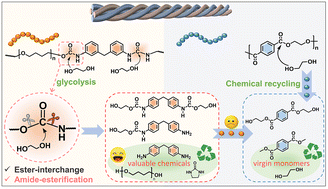New insights into urethane alcoholysis enable chemical full recycling of blended fabric waste†
Abstract
Accumulation and mishandling of post-consumer polymers have created environmental concerns worldwide. Chemical recycling represents a promising strategy by converting waste polymers into valuable monomers, fuels or chemicals. However, due to multi-component features and similar chemical activities, the chemical recycling of major polymer components often comes at the expense of minor polymer components. Herein, starting from ubiquitous textiles, the effect of spandex on the chemical recycling of polyester is studied qualitatively and quantitatively. Although the spandex content in blended fabrics is low (6%), it has great impact on polyester recycled monomers (recovery rate decreased by 32.4% and chromaticity no longer meets standards). Urethane alcoholysis of spandex is the main depolymerization reaction. Importantly, we reveal for the first time that the amide-esterification reaction occurs during urethane alcoholysis, whereas the reported literature proposes that only ester-interchange reaction occurs. The new insights into urethane alcoholysis not only break the traditional inherent understanding and enrich urethane-based chemistry, but also enable chemical-full-recycling of both major-polyester and minor-spandex.

- This article is part of the themed collection: 2022 Green Chemistry Hot Articles


 Please wait while we load your content...
Please wait while we load your content...